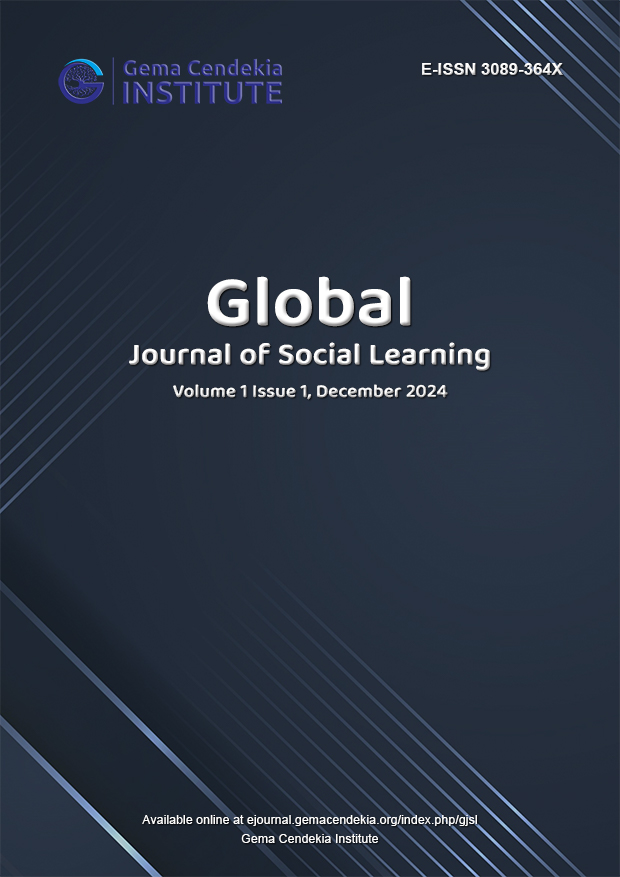The Existence of Bekayat Tradition in Sembung Village, Narmada Subdistrict, West Lombok
DOI:
https://doi.org/10.71094/gjsl.v1i1.6Keywords:
Bekayat, Oral Tradition, Existence, Traditional Art, SembungAbstract
Traditional arts often face challenges in evolving with the times. The processes of inheritance and preservation become common diction and challenges in maintaining the existence of traditional arts. This is one of the issues faced by the traditional art group Bekayat in Sembung Village, Narmada Subdistrict, West Lombok Regency. Observing such a reality of tradition, researching the existence of the Bekayat tradition becomes an interesting topic. The goal is to understand the reality of the Bekayat tradition through the analysis of its form, function, and inheritance process in maintaining its existence. A descriptive qualitative method is used to address the issues, with data collection techniques including observation, interviews, and documentation. To test the validity of the data, the researcher uses triangulation techniques. The results show that the existence of the Bekayat tradition in Sembung Village, Narmada Subdistrict, West Lombok Regency has weakened. Several factors contribute to the weakening existence of this tradition, namely: 1) Political factors. 2) Economic factors. 3) Regeneration factors.
References
Anggarista, R. (2022). Revitalisasi Sastra Lisan Sasak Berbasis Komunitas: Pemodelan Bekayat di Kalangan Pemuda Lombok. Jurnalistrendi: Jurnal Linguistik, Sastra, Dan Pendidikan, 7(2), 198-210.
Daud, H. (2008). Analisis Data Penelitian Tradisi Lisan Kelantan. dalam Metodologi Kajian Tradisi Lisan.
Elvandari, E. (2020). Sistem Pewarisan Sebagai Upaya Pelestarian Seni Tradisi. GETER: Jurnal Seni Drama, Tari dan Musik, 3(1), 93-104.
Ghufron, G. (2021). Manajemen Konflik Dan Penyelesaiannya Dalam Pandangan Islam. At-Turost: Journal of Islamic Studies, 8(1), 59-83.
Irianto, A. M. (2015). Mengemas kesenian tradisional dalam bentuk industri kreatif: Studi kasus kesenian jathilan. HUMANIKA Vol. 22 No. 2 (2015) ISSN 1412-9418, 22(2).
Irianto, A. M. (2017). Kesenian Tradisional Sebagai Sarana Strategi Kebudayaan di Tengah Determinasi Teknologi Komunikasi. Nusa: Jurnal Ilmu Bahasa dan Sastra, 12(1), 90-100.
Kurniawan, A. (2020). Nilai Budaya Dalam Takepan Pada Upacara Adat Masyarakat Desa Lenek Kabupaten Lombok Timur. AlIlm, 2(1), 61-76.
Maxwell, J. A. (2008). Designing a qualitative study (Vol. 2, pp. 214-253). The SAGE handbook of applied social research methods.
Pereira, C. (2017). Religious dances and tourism: perceptions of the “tribal” as the repository of the traditional in Goa, India. Etnográfica. Revista do Centro em Rede de Investigação em Antropologia, 21(1)), 125-152.
Sigai, E. R. L. (2018). Tradisi Ngokoi Okan Perentehu Dayak Lawangan: Pendekatan Fungsional Struktural Talcott Parson. Dharma Duta, 16(1).
Sugita, I. W. (2021). Strategi Pewarisan Seni Pertunjukan Drama Gong kepada Generasi Penerus. Kalangwan Jurnal Pendidikan Agama, Bahasa dan Sastra, 11(2), 154-163.
Suyasa, I. M. (2022). Artikulasi Sastra Melayu dalam Tradisi Lisan Sasak di Lombok. Jurnal Ilmiah Telaah, 7(1), 150-157.
Suyasa, M. (2012). Bekayat Sasak di Lombok antara Kelisanan dan Keberaksaraan. Mabasan, 6(2), 287819
Downloads
Published
Issue
Section
License
Copyright (c) 2024 Syahrul Qirom, Beny Permana, Subhan (Author)

This work is licensed under a Creative Commons Attribution-ShareAlike 4.0 International License.










